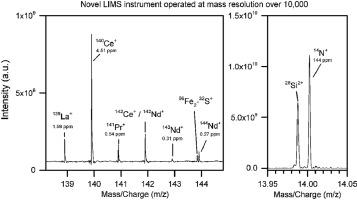International Journal of Mass Spectrometry ( IF 1.8 ) Pub Date : 2021-07-01 , DOI: 10.1016/j.ijms.2021.116662 Coenraad P. de Koning , Salome Gruchola , Andreas Riedo , Reto Wiesendanger , Valentine Grimaudo , Rustam Lukmanov , Niels F.W. Ligterink , Marek Tulej , Peter Wurz

|
Laser ablation is a highly suitable and widely applied technique for direct sampling of solid materials. The Laser Mass Spectrometer – Gran Turismo (LMS-GT), a Femtosecond Laser Ablation Ionization Time-of-Flight Mass Spectrometer with a mass resolution exceeding 10,000 (m/Δm at full-width half-maximum), was recently developed at the University of Bern with the aim of minimizing isobaric interferences and consequently improving the performance of the LIMS measurement technique for the quantification of the chemical composition of solids. To assess the quantitative performance of LMS-GT, mass spectrometric analysis four standard reference materials was conducted. The presented study shows that the achieved mass resolution of up to 12,000 is accompanied by high mean mass accuracy better than 10 ppm, with some elements displaying a deviation up to 100 ppm. Combined, these instrumental characteristics minimize isobaric interferences, which aids in confident identification and quantification of the chemical composition of solids. Limits of detection in the ppb-range and a linear dynamic range of over six orders of magnitude were achieved. Relative sensitivity coefficients were determined to lie between 0.5 and 5 for elements unaffected by loss of signal amplification with respect to the published values for bulk abundances. The lateral resolution of several micrometers achieved with LMS-GT allowed information on sample homogeneity at a micrometer scale to be acquired, with several elements (e.g., Mg, S, and Ca) showing variations in local abundances spanning a full order of magnitude. The combination of detection sensitivity, high mass resolution, and lateral resolution at the single-digit micrometer scale (down to ∼2 μm) gives the LMS-GT the potential to be an interesting analytical tool for element analysis of solid samples, and represents a step forward for laser ablation ionization mass spectrometry as a measurement technique. However, steps to ensure a smaller range in relative sensitivity values, e.g., switching to UV laser irradiation, are required to further enhance the quantitative performance of this instrument, especially the event that no reference material is available for quantification.
中文翻译:

使用 LMS-GT 进行定量元素分析;下一代 LIMS-TOF 仪器
激光烧蚀是一种非常适合且广泛应用于固体材料直接取样的技术。激光质谱仪 – Gran Turismo (LMS-GT) 是一种飞秒激光烧蚀电离飞行时间质谱仪,质量分辨率超过 10,000(全宽半最大值处的 m/Δm),最近在大学开发Bern 的目标,旨在最大限度地减少同量异位素干扰,从而提高 LIMS 测量技术在固体化学成分定量方面的性能。为了评估 LMS-GT 的定量性能,对四种标准参考物质进行了质谱分析。所呈现的研究表明,所达到的质量分辨率高达 12,000,同时具有优于 10 ppm 的高平均质量准确度,一些元素显示的偏差高达 100 ppm。综合起来,这些仪器特性可最大限度地减少同量异位素干扰,这有助于可靠地识别和量化固体的化学成分。达到了 ppb 范围内的检测限和超过六个数量级的线性动态范围。对于未受信号放大损失影响的元素,相对于已公布的体积丰度值,相对灵敏度系数被确定为介于 0.5 和 5 之间。使用 LMS-GT 实现的几个微米的横向分辨率允许获得微米级样品均匀性的信息,其中几种元素(例如,Mg、S 和 Ca)显示出跨越整个数量级的局部丰度变化。检测灵敏度的组合,单位数微米级(低至 ∼2 μm)的高质量分辨率和横向分辨率使 LMS-GT 有可能成为固体样品元素分析的有趣分析工具,并代表激光烧蚀电离向前迈进了一步质谱作为一种测量技术。然而,需要采取措施确保相对灵敏度值的范围更小,例如切换到紫外激光照射,以进一步提高该仪器的定量性能,尤其是在没有可用于定量的参考材料的情况下。并且代表了激光烧蚀电离质谱作为一种测量技术向前迈进了一步。然而,需要采取措施确保相对灵敏度值的范围更小,例如切换到紫外激光照射,以进一步提高该仪器的定量性能,尤其是在没有可用于定量的参考材料的情况下。并且代表了激光烧蚀电离质谱作为一种测量技术向前迈进了一步。然而,需要采取措施确保相对灵敏度值的范围更小,例如切换到紫外激光照射,以进一步提高该仪器的定量性能,尤其是在没有可用于定量的参考材料的情况下。


























 京公网安备 11010802027423号
京公网安备 11010802027423号